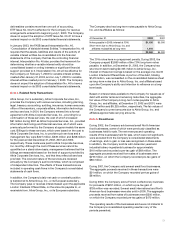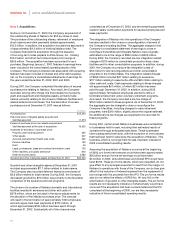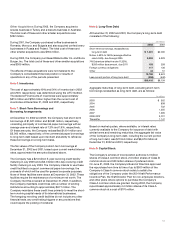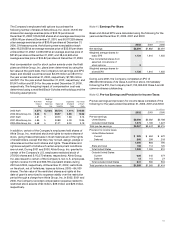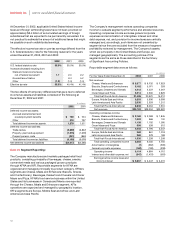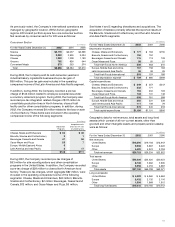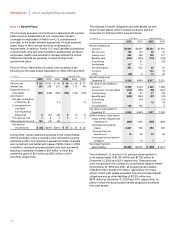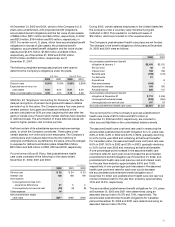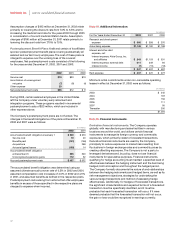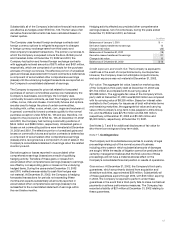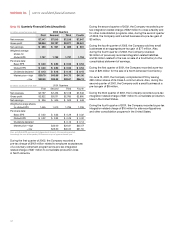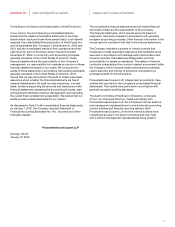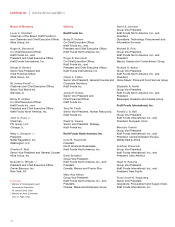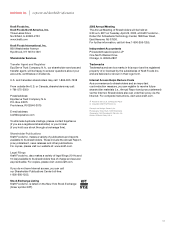Kraft 2002 Annual Report Download - page 63
Download and view the complete annual report
Please find page 63 of the 2002 Kraft annual report below. You can navigate through the pages in the report by either clicking on the pages listed below, or by using the keyword search tool below to find specific information within the annual report.
At December 31, 2002 and 2001, certain of the Company’s U.S.
plans were underfunded, with projected benefit obligations,
accumulated benefit obligations and the fair value of plan assets
of $269 million, $217 million and $45 million, respectively, in 2002
and $213 million, $164 million and $15 million, respectively, in
2001. For certain non-U.S. plans, which have accumulated benefit
obligations in excess of plan assets, the projected benefit
obligation, accumulated benefit obligation and fair value of plan
assets were $1,375 million, $1,250 million and $424 million,
respectively, as of December 31, 2002 and $1,165 million,
$1,073 million and $416 million, respectively, as of
December 31, 2001.
The following weighted-average assumptions were used to
determine the Company’s obligations under the plans:
U.S. Plans Non-U.S. Plans
2002 2001 2002 2001
Discount rate 6.50% 7.00% 5.56% 5.80%
Expected rate of return on
plan assets 9.00 9.00 8.41 8.49
Rate of compensation increase 4.00 4.50 3.12 3.36
SFAS No. 87, “Employers’ Accounting for Pensions,” permits the
delayed recognition of pension fund gains and losses in ratable
periods of up to five years. The Company uses a four-year period
wherein pension fund gains and losses are reflected in the
pension calculation at 25% per year, beginning the year after the
gains or losses occur. Recent stock market declines have resulted
in deferred losses. The amortization of these deferred losses will
result in higher pension cost in future periods.
Kraft and certain of its subsidiaries sponsor employee savings
plans, to which the Company contributes. These plans cover
certain salaried, non-union and union employees. The Company’s
contributions and costs are determined by the matching of
employee contributions, as defined by the plans. Amounts charged
to expense for defined contribution plans totaled $64 million,
$63 million and $43 million in 2002, 2001 and 2000, respectively.
Postretirement Benefit Plans: Net postretirement health
care costs consisted of the following for the years ended
December 31, 2002, 2001 and 2000:
(in millions)
2002 2001 2000
Service cost $32 $34 $23
Interest cost 168 168 109
Amortization:
Unrecognized net loss from
experience differences 21 52
Unrecognized prior service cost (20) (8) (8)
Other expense 16
Net postretirement health
care costs $217 $199 $126
During 2002, certain salaried employees in the United States left
the Company under a voluntary early retirement program
instituted in 2001. This resulted in curtailment losses of
$16 million, which are included in other expense above.
The Company’s postretirement health care plans are not funded.
The changes in the benefit obligations of the plans at December
31, 2002 and 2001 were as follows:
(in millions)
2002 2001
Accumulated postretirement benefit
obligation at January 1 $2,436 $2,102
Service cost 32 34
Interest cost 168 168
Benefits paid (199) (172)
Curtailments 21
Acquisitions 8
Plan amendments (164) 1
Assumption changes 193 180
Actuarial losses 225 115
Accumulated postretirement benefit
obligation at December 31 2,712 2,436
Unrecognized actuarial losses (848) (464)
Unrecognized prior service cost 197 53
Accrued postretirement health care costs $2,061 $2,025
The current portion of the Company’s accrued postretirement
health care costs of $172 million and $175 million at
December 31, 2002 and 2001, respectively, are included in
other accrued liabilities on the consolidated balance sheets.
The assumed health care cost trend rate used in measuring the
accumulated postretirement benefit obligation for U.S. plans was
6.8% in 2001, 6.2% in 2002 and 8.0% in 2003, gradually declining
to 5.0% by the year 2006 and remaining at that level thereafter.
For Canadian plans, the assumed health care cost trend rate was
9.0% in 2001, 8.0% in 2002 and 7.0% in 2003, gradually declining
to 4.0% by the year 2006 and remaining at that level thereafter.
A one-percentage-point increase in the assumed health care
cost trend rates for each year would increase the accumulated
postretirement benefit obligation as of December 31, 2002, and
postretirement health care cost (service cost and interest cost)
for the year then ended by approximately 8.8% and 11.9%,
respectively. A one-percentage-point decrease in the assumed
health care cost trend rates for each year would decrease
the accumulated postretirement benefit obligation as of
December 31, 2002, and postretirement health care cost (service
cost and interest cost) for the year then ended by approximately
7.3% and 10.0%, respectively.
The accumulated postretirement benefit obligations for U.S. plans
at December 31, 2002 and 2001 were determined using an
assumed discount rate of 6.5% and 7.0%, respectively. The
accumulated postretirement benefit obligations for Canadian
plans at December 31, 2002 and 2001 were determined using an
assumed discount rate of 6.75%.
59




